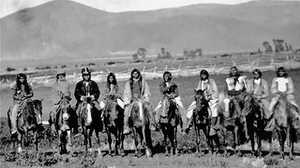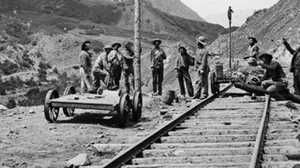Transcontinental Railroad Timeline

1769
Scottish mechanical engineer James Watt patents his design for the first practical steam engine, paving the way for the mechanized production of the Industrial Revolution.
1825
In England, George Stephenson engineers the world's first railway locomotive. Based on Stephenson's years of experimentation with steam-driven vehicles (the first of which he built in 1814), the Locomotion pulls coal on a nine-mile track.
1830
Peter Cooper finishes America's first steam locomotive. The Tom Thumb carries passengers and goods along 13 miles of track between Baltimore and Ellicott's Mills, Maryland. By year's end, similar locomotive routes exist in New York and South Carolina.
1841
The first settlers move westward across the Northern Great Plains on what will come to be known as the Oregon Trail, soon a conduit for emigration.
1845
Asa Whitney presents a resolution in Congress endorsing the funding of a railroad to the Pacific. Despite six years of campaigning, the issue dies as increased sectionalism and self-interest distract the legislature. The railroad remains a potent symbol in the public consciousness.
1848
December: Outgoing president James K. Polk stirs a new fervor for westward expansion by announcing the discovery of gold in Oregon Territory.
1850
September 9: Gold-rich California becomes the 31st state admitted into the Union.
1859
June: Discovery of the massive Comstock Lode lures miners to Virginia City, Nevada, in search of gold and silver ore. The news revitalizes the California mining economy, and urges exploration of a road east across the Sierra Nevada.
1860
July: Engineer and enthusiast Theodore Judah solves the great riddle of the Pacific Railroad when he reaches Donner Pass (named for the ill-fated emigrantof 1846). Judah immediately recognizes the location as ideal for constructing a line through the Sierra Nevada.
November: Judah meets Sacramento merchant Collis P. Huntington, who agrees to invest in his railroad project. Huntington brings in four other investors: Mark Hopkins, James Bailey, Charles Crocker, and Leland Stanford. The six men organize themselves as the first Board of Directors of the Central Pacific Railroad Company.
1861
October: Having completed his survey of the Sierra Nevada, Judah returns to Washington armed with maps and profiles to lobby for appropriations for the Central Pacific Railroad Company.
1862
July 1: Congress passes and Lincoln signs the Pacific Railroad Bill. The document endorses Central Pacific efforts to build the California line while simultaneously chartering a Union Pacific Railroad Company to build west from the Missouri River. The bill grants each enterprise 6,400 acres of land and $48,000 in government bonds per mile built. It does not designate a meeting point for the lines.
1863
January 8: Newly-elected California governor Leland Stanford shovels the first load of dirt at the Central Pacific groundbreaking ceremony in Sacramento.
Summer: Tensions build among the Central Pacific board around financial and contractual issues. Judah sails East to look for new investors.
October 26: The Central Pacific spikes its first rails to ties.
October 30: Thomas C. Durant, who has illegally manipulated a controlling interest in the Union Pacific Railroad Company, gets himself appointed the railroad's vice president and general manager.
November 2: Taken ill on his journey, Theodore Judah dies in New York City.
December 2: In a gala ceremony, the Union Pacific breaks ground in Omaha, Nebraska, although it is some time before the railroad will go anywhere.
1864
July 1: As lobbyists -- among them Durant, who hands out upwards of $400,000 -- distribute cash and bonds among legislators, Congress passes a revised Pacific Railroad Bill. It doubles the land grant, cedes all natural resources on the line to the railroads, and removes limitations on individual stock ownership.
October: Union Pacific crony Herbert M. Hoxie wins the Union Pacific construction bid, then signs the contract over to Durant's new company, Crédit Mobilier. The move allows Durant to pay himself for construction, generating giant profits without congressional oversight.
November 29: The Sand Creek Massacre. Cavalrymen led by Colonel John Chivington slaughter 150 unarmed Cheyenne and Arapaho Native Americans, most of whom are women and children.
1865
January 7: Cheyenne, Arapaho, and Sioux raiders ravage the would-be railroad town of Julesburg, Colorado, in retaliation for Sand Creek. They destroy telegraph wire in Platte Valley, then return and raze Julesburg to the ground.
January 20: President Abraham Lincoln asks Massachusetts senator Oakes Ames to help manage the Union Pacific Railroad. Ames soon invests in Crédit Mobilier and promotes its interests in Washington, D.C.
Late January: Contractor Charles Crocker convinces Central Pacific foreman James Harvey Strobridge to try Chinese workers as a means of expanding their labor force, which at this time numbers just a few hundred Irishmen.
April 9: Robert E. Lee surrenders to Ulysses S. Grant. The Civil War ends. Masses of soldiers demobilize, many of whom will soon move west. The Union Pacific has yet to spike a rail.
April 14: President Lincoln is assassinated. His body will be carried back to Illinois by rail, on a special Pullman car.
July 10: With Durant's activities facing increased scrutiny in D.C., the first rails of the Union Pacific line are spiked in Omaha.
Late Summer: Central Pacific crews begin the slow job of hand-drilling 12 tunnels through the Sierra Nevada, averaging a few inches through the rock a day. By year's end approximately 6,000 Chinese men will work in and around the tunnels. They will constitute up to 80% of the workforce throughout the project.
1866
February: Realizing the importance of increasing production, Durant hires General Jack Casement as the Union Pacific's construction boss. Casement spends the winter at Omaha, preparing the rolling dormitories his crews will use in the coming year.
April 16: A nitroglycerin explosion destroys the Wells Fargo Office in downtown San Francisco.
May: Durant hires General Grenville Dodge to be chief engineer of the Union Pacific.
July: Casement crews add 60 miles of track to bring the Union Pacific line to the 100 mile mark.
October 6: Casement and his crews pass the 100th Meridian line on the prairies of Nebraska, thus guaranteeing the Union Pacific the irrevocable right to continue westward, as stipulated in the Pacific Railroad Act. Durant throws a grand "100th Meridian Excursion" for dignified guests, featuring a mock Pawnee ambush.
November: North Platte, Nebraska, sits at the end of the Union Pacific line, and soon features a potent combination of saloons, prostitutes, and criminals. This assemblage and the others like it that follow the westward press of empire are named "Hell on Wheels" towns.
December 21: Upset by increased military presence in the Powder River Valley, the most sacred and fertile hunting ground remaining in their possession, a group of Sioux warriors draws cocky Captain William J. Fetterman and his troops into a deadly ambush on the Bozeman trail.

1867
Winter: British chemist James Howden begins manufacturing nitroglycerin on-site in the mountains for the Central Pacific, eliminating the dangers of transporting the compound.
May: Led by the Ames brothers, officers of the Crédit Mobilier remove Durant from the Union Pacific presidency. Thus begins a flurry of legal action initiated by Durant against both Crédit Mobilier and the Union Pacific, even though he continues to exert nominal leadership over both companies.
June 25: Summit work in the Sierras grinds to a halt as Chinese workers strike for better wages and shorter hours. Crocker and Strobridge cut off food, supplies, and communication to the Chinese camps. One week later, the men will go back to work at the same wage.
July 4: Dodge founds the town of Cheyenne in Wyoming Territory. Intended as a transfer point on the Union Pacific line, it will contain the company roundhouse and a military station. The company divides and sells lots to encourage emigrant settlement. By year's end, the settlement's population will exceed 4,000.
August 27: A group of Cheyenne warriors bends rails and pulls up track at Plum Creek, Nebraska. The resulting destruction derails a work train, which the Cheyenne party loots and burns after killing its crew. The only survivor escapes with scalp in hand.
August 28: Central Pacific workers blast through the rock of the Summit Tunnel, completing the most arduous of their tasks in the mountains.
November 30: As the Chinese lay track, Central Pacific directors lead a ceremonial train excursion to the eastern side of the Sierra Nevada.
December 12: Despite continued infighting among its directors, Crédit Mobilier declares a substantial stock dividend. Oakes Ames becomes popular among legislators eager to get in on the profits. Ames distributes 190 shares of stock in Washington, 163 of which go to 11 members of Congress.
1868
April 16: Union Pacific construction surmounts the highest point on both lines: Sherman Summit, at an elevation of 8,200 feet in the Rockies. The race for completion -- and territorial holdings -- is on.
May 9: The Central Pacific sells its first lots in Reno, Nevada.
June 18: The first passenger train rumbles across the Sierras into Reno.
August: Mormon leader Brigham Young provides Stanford with Mormon laborers for Central Pacific grading work through the Utah desert.
October 29: The fed-up citizens of Laramie, Wyoming, form a Vigilance Committee to combat the town's lawless element. Following a feverish gun battle, the vigilantes succeed in forcing gamblers and outlaws from their settlement, hanging those who remain from telegraph poles and log cabin rafters.
November 6: After months of skirmishes known as "Red Cloud's War," the government suggests a treaty, but Native American leader Red Cloud will not condescend to meet until the military have removed themselves from the Bozeman Trail. They agree, and Red Cloud signs the Powder River Treaty, which guarantees the Sioux their massive hunting ground in perpetuity. Red Cloud is thus considered the only native leader to have won a war with the United States.
1869
January: Corinne, Utah is founded. It is the first non-Mormon settlement in the Territory; it will prove to be the last true Hell on Wheels town.
April 8: After months of increased tension, closed-door Washington lobbying, Congressional pressure, and aborted meetings between the two companies, Dodge and Huntington settle upon a meeting place for their two lines. It takes two days' worth of tempestuous argument, but the men negotiate convergence at Promontory Summit, Utah.
April 28: Victory Day. Charles Crocker decides he has one last thing to show the Union Pacific and the world. In a remarkable feat of strength and organization, his Central Pacific crews lay an unheard-of 10 miles of rail between sunrise and sunset.
May 6: As Pullman cars move westward toward Promontory Summit, unpaid tie workers block the line and a bridge washes out at Devil's Gate. These developments delay the arrival of Durant and Union Pacific dignitaries by two days.
May 8: Despite the delay, jubilees proceed as planned in cities throughout California. At the Central Pacific ceremony in Sacramento, toasts are raised to the pioneering visions of Asa Whitney and Theodore Judah.
May 10: Amidst a crowd of dignitaries and workers, with the engines No. 119 and Jupiter practically touching noses, the Central Pacific and Union Pacific railroads join together. Telegraph operators transmitting to both coasts transmit the blows of the hammer as they fall on a golden spike. The nation listens as west and east come together in undivided union.
1872
September 4: During a heated presidential campaign, the Crédit Mobilier scandal erupts in the press, smearing the name of many established government figures who purportedly sold their influence for Crédit Mobilier stock. Among them is Speaker of the House James G. Blaine of Maine, who suggests an investigating committee will find the allegations worthless.
1873
February: A Congressional committee investigates the Crédit Mobilier. The scandal creates public disillusionment with elected leaders, but the committee hands out very little punishment. All major players escape unscathed, save scapegoat Oakes Ames, who is voted out of Congress and leaves Washington in shame. He will die just months later.
1880
By 1880, the Pacific railroad carries $50 million worth of freight annually. It has served as artery for 200 million acres of settlement between the Mississippi and the Pacific. The Plains Indians have been scattered to reservations, and little over 1,000 buffalo remain of the millions that once populated the grasslands. A trip between San Francisco and New York, which once might have occupied six grueling months, now takes a few days.
1882
Ignoring the crucial role Chinese immigrants played in constructing the California infrastructure, Congress passes the Chinese Exclusion Act, banning further immigration of Chinese laborers into the United States for a period of ten years. Congress will extend this Act in 1892, and again indefinitely in 1904.
1884
Bursting with the profit of the railroad enterprise and bereft over the death of their teenage son, Leland and Jane Stanford endow the Leland Stanford Junior University on family land in Palo Alto, California.
1889
An agreement with the U.S. government divides up Sioux territory in the Powder River Valley, once promised to Native Americans in perpetuity by the Treaty of 1868. The Sioux disperse to six smaller disconnected reservations, and the last great holding of an indigenous people is thrown open to white settlement.









